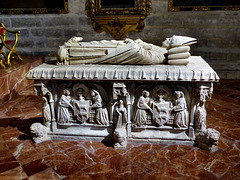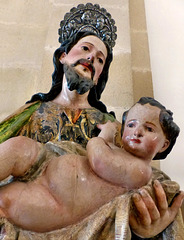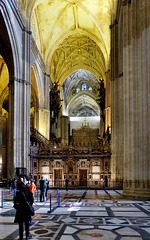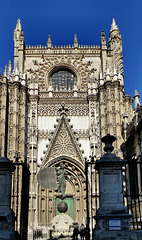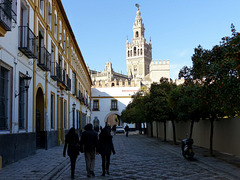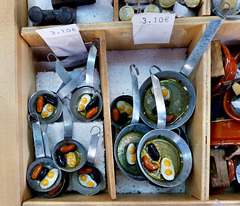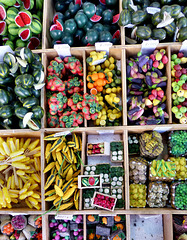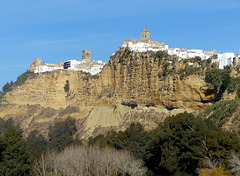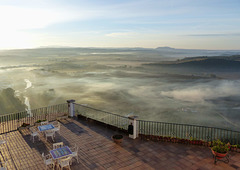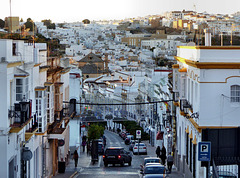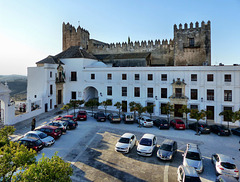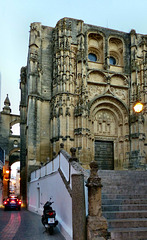Martin M. Miles' photos
Sevilla - Catedral de Santa María de la Sede
| |
|
Seville was a Roman "colonia" since 45BC. The important city got looted by the Vandals in 428 and developed into a Bishopric seat under Visigothic rule. After the Moors had defeated the Visigoths in the Battle of Guadalete, the conquered Seville and made it the capital of a province. Normans devastated Seville in 844 but Seville got rebuilt and flourished under the different Moorish dynasties.
In 1248 Seville was conquered by the troops of Ferdinand III of Castile. The emigration of hundredthousands of Moors to Northern Africa led to a decrease of economics in the whole area. Seville recovered in the 16th and 17th century, when it became the hub of Spanish maritime trade. During this period, the port of Seville had a monopoly on overseas trade. Vespucci and Magellan planned and started their voyages here.
The Cathedral "Catedral de Santa María de la Sede" was erected between 1401 and 1519 on the remains of the Great Mosque of Seville, built in the 12th century.
With about 11,520m² this is the third-largest church in the world as well as the largest Gothic church. The Cathedral in Cologne covers about 7,900m².
The Great Mosque of Seville was dedicated in 1172 and completed 1198. It was a rectangular building 113m x 135m inculding a minaret ("La Giralda") and a courtyard. After the conquest the mosque was converted into the city's cathedral. The orientation was changed and it got divided into chapels by new walls. In 1401 it was decided to build a new cathedral and replace the mosque, that had served as a cathedral. In 1551, 5 years after construction ended, the crossing lantern ("cimborrio"), collapsed and was rebuilt. It collapsed again in 1888, and work continued until 1903.
The cathedral of today is 115m long and 76 m wide. There are five naves, the vaultig over the central one is 42m high.
Sevilla - Catedral de Santa María de la Sede
| |
|
|
Seville was a Roman "colonia" since 45BC. The important city got looted by the Vandals in 428 and developed into a Bishopric seat under Visigothic rule. After the Moors had defeated the Visigoths in the Battle of Guadalete, the conquered Seville and made it the capital of a province. Normans devastated Seville in 844 but Seville got rebuilt and flourished under the different Moorish dynasties.
In 1248 Seville was conquered by the troops of Ferdinand III of Castile. The emigration of hundredthousands of Moors to Northern Africa led to a decrease of economics in the whole area. Seville recovered in the 16th and 17th century, when it became the hub of Spanish maritime trade. During this period, the port of Seville had a monopoly on overseas trade. Vespucci and Magellan planned and started their voyages here.
The Cathedral "Catedral de Santa María de la Sede" was erected between 1401 and 1519 on the remains of the Great Mosque of Seville, built in the 12th century.
With about 11,520m² this is the third-largest church in the world as well as the largest Gothic church. The Cathedral in Cologne covers about 7,900m².
The Great Mosque of Seville was dedicated in 1172 and completed 1198. It was a rectangular building 113m x 135m inculding a minaret ("La Giralda") and a courtyard. After the conquest the mosque was converted into the city's cathedral. The orientation was changed and it got divided into chapels by new walls. In 1401 it was decided to build a new cathedral and replace the mosque, that had served as a cathedral. In 1551, 5 years after construction ended, the crossing lantern ("cimborrio"), collapsed and was rebuilt. It collapsed again in 1888, and work continued until 1903.
The cathedral of today is 115m long and 76 m wide. There are five naves, the vaultig over the central one is 42m high.
The tomb of Cardinal Juan de Cervantes (1380 - 1453), created by Lorenzo Mercadante de Bretaña, a Breton sculptor, who worked in Seville mid 15th century.
Sevilla - Catedral de Santa María de la Sede
| |
|
|
|
Seville was a Roman "colonia" since 45BC. The important city got looted by the Vandals in 428 and developed into a Bishopric seat under Visigothic rule. After the Moors had defeated the Visigoths in the Battle of Guadalete, the conquered Seville and made it the capital of a province. Normans devastated Seville in 844 but Seville got rebuilt and flourished under the different Moorish dynasties.
In 1248 Seville was conquered by the troops of Ferdinand III of Castile. The emigration of hundredthousands of Moors to Northern Africa led to a decrease of economics in the whole area. Seville recovered in the 16th and 17th century, when it became the hub of Spanish maritime trade. During this period, the port of Seville had a monopoly on overseas trade. Vespucci and Magellan planned and started their voyages here.
The Cathedral "Catedral de Santa María de la Sede" was erected between 1401 and 1519 on the remains of the Great Mosque of Seville, built in the 12th century.
With about 11,520m² this is the third-largest church in the world as well as the largest Gothic church. The Cathedral in Cologne covers about 7,900m².
The Great Mosque of Seville was dedicated in 1172 and completed 1198. It was a rectangular building 113m x 135m inculding a minaret ("La Giralda") and a courtyard. After the conquest the mosque was converted into the city's cathedral. The orientation was changed and it got divided into chapels by new walls. In 1401 it was decided to build a new cathedral and replace the mosque, that had served as a cathedral. In 1551, 5 years after construction ended, the crossing lantern ("cimborrio"), collapsed and was rebuilt. It collapsed again in 1888, and work continued until 1903.
The cathedral of today is 115m long and 76 m wide. There are five naves, the vaultig over the central one is 42m high.
Sevilla - Catedral de Santa María de la Sede
| |
|
Seville was a Roman "colonia" since 45BC. The important city got looted by the Vandals in 428 and developed into a Bishopric seat under Visigothic rule. After the Moors had defeated the Visigoths in the Battle of Guadalete, the conquered Seville and made it the capital of a province. Normans devastated Seville in 844 but Seville got rebuilt and flourished under the different Moorish dynasties.
In 1248 Seville was conquered by the troops of Ferdinand III of Castile. The emigration of hundredthousands of Moors to Northern Africa led to a decrease of economics in the whole area. Seville recovered in the 16th and 17th century, when it became the hub of Spanish maritime trade. During this period, the port of Seville had a monopoly on overseas trade. Vespucci and Magellan planned and started their voyages here.
The Cathedral "Catedral de Santa María de la Sede" was erected between 1401 and 1519 on the remains of the Great Mosque of Seville, built in the 12th century.
With about 11,520m² this is the third-largest church in the world as well as the largest Gothic church. The Cathedral in Cologne covers about 7,900m².
The Great Mosque of Seville was dedicated in 1172 and completed 1198. It was a rectangular building 113m x 135m inculding a minaret ("La Giralda") and a courtyard. After the conquest the mosque was converted into the city's cathedral. The orientation was changed and it got divided into chapels by new walls. In 1401 it was decided to build a new cathedral and replace the mosque, that had served as a cathedral. In 1551, 5 years after construction ended, the crossing lantern ("cimborrio"), collapsed and was rebuilt. It collapsed again in 1888, and work continued until 1903.
The cathedral of today is 115m long and 76 m wide. There are five naves, the vaultig over the central one is 42m high.
There are many Baroque sculptures in the cathedral. Some created by famous artists like Alonso Martínez or Martínez Montañés. I could not find out who created this Saint Joseph.
Sevilla - Catedral de Santa María de la Sede
| |
|
Seville was a Roman "colonia" since 45BC. The important city got looted by the Vandals in 428 and developed into a Bishopric seat under Visigothic rule. After the Moors had defeated the Visigoths in the Battle of Guadalete, the conquered Seville and made it the capital of a province. Normans devastated Seville in 844 but Seville got rebuilt and flourished under the different Moorish dynasties.
In 1248 Seville was conquered by the troops of Ferdinand III of Castile. The emigration of hundredthousands of Moors to Northern Africa led to a decrease of economics in the whole area. Seville recovered in the 16th and 17th century, when it became the hub of Spanish maritime trade. During this period, the port of Seville had a monopoly on overseas trade. Vespucci and Magellan planned and started their voyages here.
The Cathedral "Catedral de Santa María de la Sede" was erected between 1401 and 1519 on the remains of the Great Mosque of Seville, built in the 12th century.
With about 11,520m² this is the third-largest church in the world as well as the largest Gothic church. The Cathedral in Cologne covers about 7,900m².
The Great Mosque of Seville was dedicated in 1172 and completed 1198. It was a rectangular building 113m x 135m inculding a minaret ("La Giralda") and a courtyard. After the conquest the mosque was converted into the city's cathedral. The orientation was changed and it got divided into chapels by new walls. In 1401 it was decided to build a new cathedral and replace the mosque, that had served as a cathedral. In 1551, 5 years after construction ended, the crossing lantern ("cimborrio"), collapsed and was rebuilt. It collapsed again in 1888, and work continued until 1903.
The cathedral of today is 115m long and 76 m wide. There are five naves, the vaultig over the central one is 42m high.
Sevilla - Catedral de Santa María de la Sede
| |
|
|
|
Seville was a Roman "colonia" since 45BC. The important city got looted by the Vandals in 428 and developed into a Bishopric seat under Visigothic rule. After the Moors had defeated the Visigoths in the Battle of Guadalete, the conquered Seville and made it the capital of a province. Normans devastated Seville in 844 but Seville got rebuilt and flourished under the different Moorish dynasties.
In 1248 Seville was conquered by the troops of Ferdinand III of Castile. The emigration of hundredthousands of Moors to Northern Africa led to a decrease of economics in the whole area. Seville recovered in the 16th and 17th century, when it became the hub of Spanish maritime trade. During this period, the port of Seville had a monopoly on overseas trade. Vespucci and Magellan planned and started their voyages here.
The Cathedral "Catedral de Santa María de la Sede" was erected between 1401 and 1519 on the remains of the Great Mosque of Seville, built in the 12th century.
With about 11,520m² this is the third-largest church in the world as well as the largest Gothic church. The Cathedral in Cologne covers about 7,900m².
The Great Mosque of Seville was dedicated in 1172 and completed 1198. It was a rectangular building 113m x 135m inculding a minaret ("La Giralda") and a courtyard. After the conquest the mosque was converted into the city's cathedral. The orientation was changed and it got divided into chapels by new walls. In 1401 it was decided to build a new cathedral and replace the mosque, that had served as a cathedral. IN 1551, 5 years after construction ended, the crossing lantern ("cimborrio"), collapsed and was rebuilt. It collapsed again in 1888, and work continued until 1903.
The cathedral of today is 115m long and 76 m wide. There are five naves, the vaultig over the central one is 42m high.
The "Puerta del Principe". The statue in front is a copy of "Giraldillo". The original is placed on top of the tower. From this statue the tower got the name "La Giralda".
Sevilla - Catedral de Santa María de la Sede
| |
|
|
Seville was a Roman "colonia" since 45BC. The important city got looted by the Vandals in 428 and developed into a Bishopric seat under Visigothic rule. After the Moors had defeated the Visigoths in the Battle of Guadalete, the conquered Seville and made it the capital of a province. Normans devastated Seville in 844 but Seville got rebuilt and flourished under the different Moorish dynasties.
In 1248 Seville was conquered by the troops of Ferdinand III of Castile. The emigration of hundredthousands of Moors to Northern Africa led to a decrease of economics in the whole area. Seville recovered in the 16th and 17th century, when it became the hub of Spanish maritime trade. During this period, the port of Seville had a monopoly on overseas trade. Vespucci and Magellan planned and started their voyages here.
The Cathedral "Catedral de Santa María de la Sede" was erected between 1401 and 1519 on the remains of the Great Mosque of Seville, built in the 12th century.
With about 11,520m² this is the third-largest church in the world as well as the largest Gothic church. The Cathedral in Cologne covers about 7,900m².
The Great Mosque of Seville was dedicated in 1172 and completed 1198. It was a rectangular building 113m x 135m including a minaret ("La Giralda") and a courtyard. After the conquest, the mosque was converted into the city's cathedral. The orientation was changed and it was divided into chapels by new walls. In 1401 it was decided to build a new cathedral and replace the mosque, that had served as a cathedral. In 1551, 5 years after construction ended, the crossing lantern ("cimborrio"), collapsed and was rebuilt. It collapsed again in 1888, and work continued until 1903.
The cathedral of today is 115m long and 76 m wide. There are five naves, the vaultig over the central one is 42m high.
Sevilla - La Giralda
| |
|
|
Seville was a Roman "colonia" since 45BC. The important city got looted by the Vandals in 428 and developed into a Bishopric seat under Visigothic rule. After the Moors had defeated the Visigoths in the Battle of Guadalete, the conquered Seville and made it the capital of a province. Normans devastated Seville in 844 but Seville got rebuilt and flourished under the different Moorish dynasties.
In 1248 Seville was conquered by the troops of Ferdinand III of Castile. The emigration of hundredthousands of Moors to Northern Africa led to a decrease of economics in the whole area. Seville recovered in the 16th and 17th century, when it became the hub of Spanish maritime trade. During this period, the port of Seville had a monopoly on overseas trade. Vespucci and Magellan planned and started their voyages here.
As a result of the War of the Spanish Succession, in 1717 Seville lost the transatlantic trade monopoly to Cádiz.
The cathedral was erected between 1401 and 1519 on the remains of the Great Mosque of Seville, built in the 12th century. The bell tower of the cathedral, named "La Giralda" was originally built in 1196 as the minaret for the Mosque from bricks. It was 82m high.
The 32m high renaissance-style top on the former minaret was completed in 1568.
Sevilla - La Giralda
| |
|
|
Seville was a Roman "colonia" since 45BC. The important city got looted by the Vandals in 428 and developed into a Bishopric seat under Visigothic rule. After the Moors had defeated the Visigoths in the Battle of Guadalete, the conquered Seville and made it the capital of a province. Normans devastated Seville in 844 but Seville got rebuilt and flourished under the different Moorish dynasties.
In 1248 Seville was conquered by the troops of Ferdinand III of Castile. The emigration of hundredthousands of Moors to Northern Africa led to a decrease of economics in the whole area. Seville recovered in the 16th and 17th century, when it became the hub of Spanish maritime trade. During this period, the port of Seville had a monopoly on overseas trade. Vespucci and Magellan planned and started their voyages here.
As a result of the War of the Spanish Succession, in 1717 Seville lost the transatlantic trade monopoly to Cádiz.
The cathedral was erected between 1401 and 1519 on the remains of the Great Mosque of Seville, built in the 12th century. The bell tower of the cathedral, named "La Giralda" was originally built in 1196 as the minaret for the Mosque from bricks. It was 82m high.
The 32m high renaissance-style top on the former minaret was completed in 1568.
Sevilla - Street Market
| |
|
|
Nativity scenes have a long tradition on the Hispanic peninsula. Well known are "Living Cribs" ("Belen Viviente"), one is in Arcos de la Frontera, where the streets are transformed to stages, where "real" people are starring. But as well miniature scenes, which are often full of details, are very popular. Many of these necessery details are offered in street markets. I found these pans with fried eggs with suausages on a treet market in Seville.
Sevilla - Street Market
| |
|
Nativity scenes have a long tradition on the Hispanic peninsula. Well known are "Living Cribs" ("Belen Viviente"), one is in Arcos de la Frontera, where the streets are transformed to stages, where "real" people are starring.
But as well miniature scenes, which are often full of details, are very popular. Many of these necessery details are offered in street markets. I found these tiny fruits and vegetables on a treet market in Seville.
Arcos de la Frontera
| |
|
|
|
Arcos de la Frontera is a one of the "Pueblos Blancos", the "White Towns of Andalusia".
The old part of the town is located on a steep cliff above the river Guadalete. Arcos was in independent Moorish town for long. Though Alphonso X of Castile expelled the Moors. The area was a frontier between the Christian and the Moorish troops upto 1492, when Granada after a long siege ultimatively fell, what ended the Reconquista.
Arcos de la Frontera - Valley
| |
|
|
Arcos de la Frontera is a one of the "Pueblos Blancos", the "White Towns of Andalusia".
The old part of the town is located on a steep cliff above the river Guadalete. Arcos was an independent Moorish town for long. Though Alphonso X of Castile expelled the Moors. The area was a frontier between the Christian and the Moorish troops upto 1492, when Granada after a long siege ultimatively fell, what ended the Reconquista.
The valley of the Guadalete river, seen from the Parador, formerly "Casa del Corregidor", in the early morning hours. The Parador is located directly on top of the steep cliff.
Arcos de la Frontera - R4
| |
|
Arcos de la Frontera is a one of the "Pueblos Blancos", the "White Towns of Andalusia".
The old part of the town is located on a steep cliff above the river Guadalete. Arcos was an independent Moorish town for long. Though Alphonso X of Castile expelled the Moors. The area was a frontier between the Christian and the Moorish troops upto 1492, when Granada after a long siege ultimatively fell, what ended the Reconquista.
A red Renault in a white town.
Arcos de la Frontera
| |
|
Arcos de la Frontera is a one of the "Pueblos Blancos", the "White Towns of Andalusia".
The old part of the town is located on a steep cliff above the river Guadalete. Arcos was an independent Moorish town for long. Though Alphonso X of Castile expelled the Moors. The area was a frontier between the Christian and the Moorish troops upto 1492, when Granada after a long siege ultimatively fell, what ended the Reconquista.
Arcos de la Frontera
| |
|
|
Arcos de la Frontera is a one of the "Pueblos Blancos", the "White Towns of Andalusia".
The old part of the town is located on a steep cliff above the river Guadalete. Arcos was an independent Moorish town for long. Though Alphonso X of Castile expelled the Moors. The area was a frontier between the Christian and the Moorish troops upto 1492, when Granada after a long siege ultimatively fell, what ended the Reconquista.
Arcos de la Frontera - Castillo de Arcos
| |
|
|
Arcos de la Frontera is a one of the "Pueblos Blancos", the "White Towns of Andalusia".
The old part of the town is located on a steep cliff above the river Guadalete. Arcos was an independent Moorish town for long. Though Alphonso X of Castile expelled the Moors. The area was a frontier between the Christian and the Moorish troops upto 1492, when Granada after a long siege ultimatively fell, what ended the Reconquista.
The "Castillo de Arcos" is located behind the city hall at the "Plaza del Cabildo". The medieval castle has Moorish roots, rebuilt in the 15th century. Other than the "Casa del Corregidor" on the opposite side of the place, that meanwhile serves as a Parador (and from where this photo was taken) the castle is still privately owned.
Arcos de la Frontera - Basilica de Santa Maria de…
| |
|
|
Arcos de la Frontera is a one of the "Pueblos Blancos", the "White Towns of Andalusia".
The old part of the town is located on a steep cliff above the river Guadalete. Arcos was an independent Moorish town for long. Though Alphonso X of Castile expelled the Moors. The area was a frontier between the Christian and the Moorish troops upto 1492, when Granada after a long siege ultimatively fell, what ended the Reconquista.
The Basilica de Santa Maria de la Asunción, located at the central "Plaza del Cabildo", is older than it seems. The building was originally started by Alphonso XIt on the site of the mosque und was completed in the 14th century. It got later largely remodeled, when it got this Baroque, Plateresque portal.
Car drivers know, that the old part of Arcos de la Frontera has same very narrow lanes.
Jump to top
- ipernity © 2007-2024
- Help & Contact
|
Club news
|
About ipernity
|
History |
ipernity Club & Prices |
Guide of good conduct
Donate | Group guidelines | Privacy policy | Terms of use | Statutes | In memoria -
Facebook
Twitter


